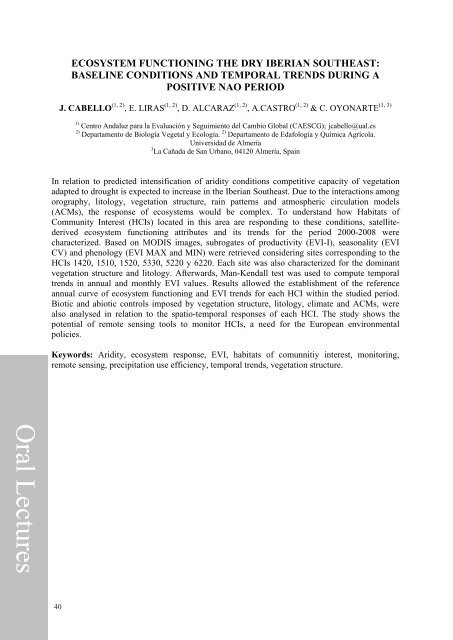Adil GÜNER, Vehbi ESER - optima
Adil GÜNER, Vehbi ESER - optima
Adil GÜNER, Vehbi ESER - optima
Create successful ePaper yourself
Turn your PDF publications into a flip-book with our unique Google optimized e-Paper software.
Oral Lectures<br />
40<br />
ECOSYSTEM FUNCTIONING THE DRY IBERIAN SOUTHEAST:<br />
BASELINE CONDITIONS AND TEMPORAL TRENDS DURING A<br />
POSITIVE NAO PERIOD<br />
J. CABELLO (1, 2) , E. LIRAS (1, 2) , D. ALCARAZ (1, 2) , A.CASTRO (1, 2) (1, 3)<br />
& C. OYONARTE<br />
1) Centro Andaluz para la Evaluación y Seguimiento del Cambio Global (CAESCG); jcabello@ual.es<br />
2) Departamento de Biología Vegetal y Ecología. 2) Departamento de Edafología y Química Agrícola.<br />
Universidad de Almería<br />
3 La Cañada de San Urbano, 04120 Almería, Spain<br />
In relation to predicted intensification of aridity conditions competitive capacity of vegetation<br />
adapted to drought is expected to increase in the Iberian Southeast. Due to the interactions among<br />
orography, litology, vegetation structure, rain patterns and atmospheric circulation models<br />
(ACMs), the response of ecosystems would be complex. To understand how Habitats of<br />
Community Interest (HCIs) located in this area are responding to these conditions, satellitederived<br />
ecosystem functioning attributes and its trends for the period 2000-2008 were<br />
characterized. Based on MODIS images, subrogates of productivity (EVI-I), seasonality (EVI<br />
CV) and phenology (EVI MAX and MIN) were retrieved considering sites corresponding to the<br />
HCIs 1420, 1510, 1520, 5330, 5220 y 6220. Each site was also characterized for the dominant<br />
vegetation structure and litology. Afterwards, Man-Kendall test was used to compute temporal<br />
trends in annual and monthly EVI values. Results allowed the establishment of the reference<br />
annual curve of ecosystem functioning and EVI trends for each HCI within the studied period.<br />
Biotic and abiotic controls imposed by vegetation structure, litology, climate and ACMs, were<br />
also analysed in relation to the spatio-temporal responses of each HCI. The study shows the<br />
potential of remote sensing tools to monitor HCIs, a need for the European environmental<br />
policies.<br />
Keywords: Aridity, ecosystem response, EVI, habitats of comunnitiy interest, monitoring,<br />
remote sensing, precipitation use efficiency, temporal trends, vegetation structure.<br />
28






